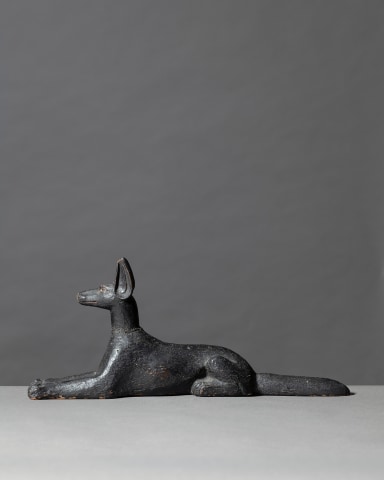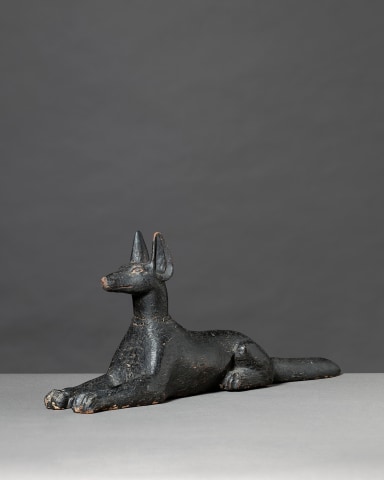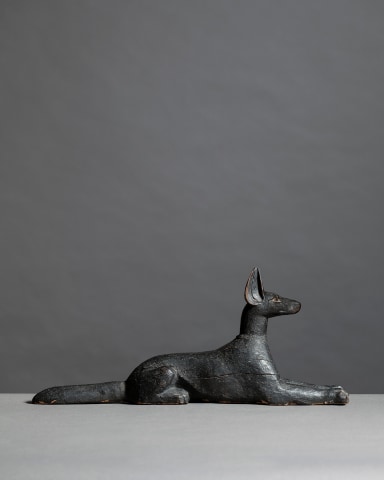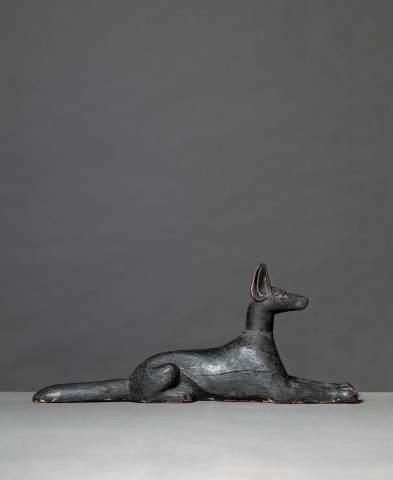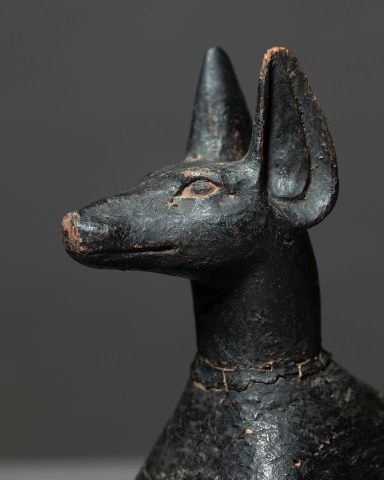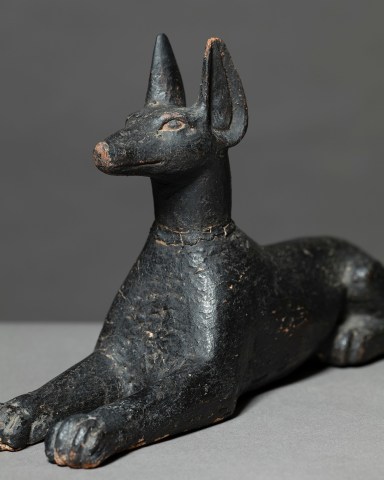Egyptian figure of Anubis as a reclining jackal, Late Dynastic Period, 25th-26th Dynasty, c.747-525 BC
Wood
Height: 19cm, length: 43.6cm
11644 TA
Copyright The Artist
€ 60,000
Further images
Statuette of Anubis in the form of a jackal, stretched out with fore paws extended in front and the tail behind. The head, with pricked ears, is raised and gazing...
Statuette of Anubis in the form of a jackal, stretched out with fore paws extended in front and the tail behind. The head, with pricked ears, is raised and gazing straight ahead. Sculpted from two pieces of wood, with the head attached to the body at the base of the neck. The surface is primed with stucco and painted black; the underside reserved and with four dowel holes.
Tip of right ear and inner left paw restored, some minor touching in of the black paint throughout.
Often depicted either in human form with the head of a dog or as a resting black jackal, Anubis symbolised the guide of souls, escorting the departed to the afterlife. Anubis, revered as the guardian of the necropolis, oversaw the ceremonial preparation of the deceased, including embalming, the opening of the mouth ritual, and burial ceremonies. The selection of canids (dogs, jackals, wolves) as symbols of this role stemmed from observations by the ancient Egyptians, who noted their frequent presence at burial sites, a behaviour perceived as potentially disturbing to the deceased. By associating Anubis with these animals, people sought to mitigate such disturbances, hoping for a peaceful transition to the next life.
From the 25th Dynasty onwards, wooden jackal figures like this one were commonly placed atop the outermost coffin lids, symbolising the protection offered by Anubis to the deceased. The dowel holes on the underside of this example suggest it would have been affixed in a similar manner.
Often depicted either in human form with the head of a dog or as a resting black jackal, Anubis symbolised the guide of souls, escorting the departed to the afterlife. Anubis, revered as the guardian of the necropolis, oversaw the ceremonial preparation of the deceased, including embalming, the opening of the mouth ritual, and burial ceremonies. The selection of canids (dogs, jackals, wolves) as symbols of this role stemmed from observations by the ancient Egyptians, who noted their frequent presence at burial sites, a behaviour perceived as potentially disturbing to the deceased. By associating Anubis with these animals, people sought to mitigate such disturbances, hoping for a peaceful transition to the next life.
From the 25th Dynasty onwards, wooden jackal figures like this one were commonly placed atop the outermost coffin lids, symbolising the protection offered by Anubis to the deceased. The dowel holes on the underside of this example suggest it would have been affixed in a similar manner.
Provenance
Elsa Bloch-Diener (1922-2012), Berne, Switzerland; acquired between 1968-1983Maria Müller, Thun, Switzerland; acquired 7th December 1983
Ronald Bullock, Brighton, UK; sold through Bonhams, 26th November 1997, lot 6
Elsa Bloch-Diener (1922-2012), Berne, Switzerland; acquired from the above
Dr Fred and Sylvia Legrain, Wabern, Switzerland; acquired 2018
This piece comes with a Radiocarbon Dating Measurement Report by RCD Lockinge from July 2024 and an analysis report concerning the study of the polychromy.
